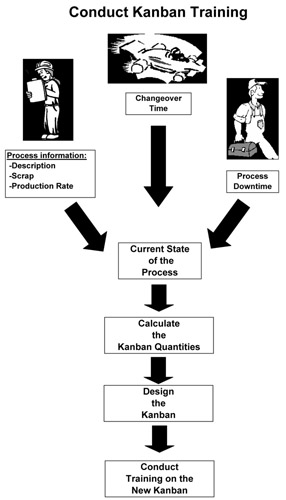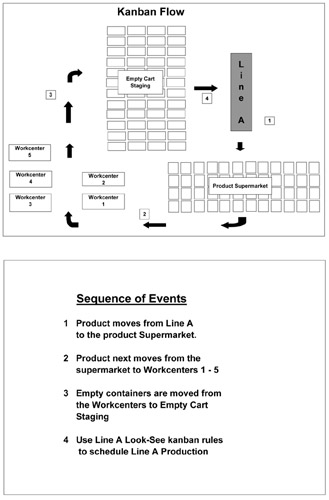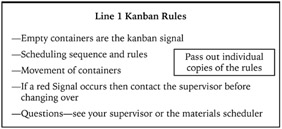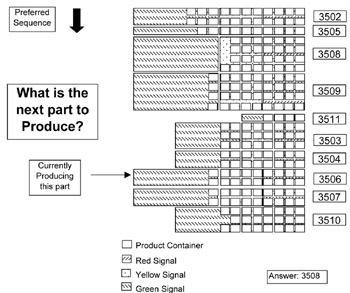Training
Overview
Chapters 4 and 5 helped you to size and design your kanban. You created the framework for controlling the operation of the line and allowing the operators to manage their schedule based on the rules you created. Now comes the time to start the deployment of your design. The deployment of the kanban will consist of training everyone who is involved in the operation of the kanban and in the set-up of the kanban itself ”signals, control points, signs, etc.
This chapter discusses creation of training material and training implementation. Our focus will be on developing the necessary material to explain how the kanban operates and what actions each participant performs . We will also develop a game plan for getting this training done before we implement the training.
In Chapter 7 we will discuss the actual startup of the kanban. However, if you do not train the people who must operate and interact with the kanban, then long- term success is questionable. Figure 6-1 shows how our kanban process flow expands to include training.

Figure 6-1: Expanded Kanban Process Flow.
Developing Your Training Material
Using the training list you developed in the last chapter to identify who needs to be trained, determine what type of training they need to fulfill their part of the operation.
For example, the material handlers probably don't need much training on making scheduling decisions. However, they will need to understand how you want the material to move and how to handle the scheduling signal ”moving the magnets or chips on a board, for example.
When creating the training, focus on how the kanban will work. We suggest the following outline for training:
- Kanban basics
- How kanban will work
- What is the signal?
- How will the material move?
- Review of the rules
- What are the scheduling decisions and the rules for making the decisions
- Use example of different schedule conditions to teach how and what decisions to make
- Discuss when to call for help and what to do specifically when encountering a red signal
- Conduct a dry run
Although this list seems long, if you prepare properly and focus the information, then you can convey all this information in seven to ten charts . Figure 6-2 shows the layout of a draft presentation.

Figure 6-2: Draft Presentation Layout.
Kanban Basics
When talking about kanban basics, avoid a lengthy discussion of kanban theory. Instead keep the discussion focused on what kanban is and what it will do for them. Some of the points that you should include:
- Kanban is demand-based scheduling . You supply product based on usage.
- They will no longer receive a schedule. The kanban signal will be their schedule.
- Use this opportunity to tell the operators that you will train them on how to use the kanban schedule and you will be there to help get them started.
- Kanban scheduling is more than just an inventory reduction strategy ”it improves flow, reduces or eliminates unexpected schedule changes, and allows them to control the line's operation.
Figure 6-3 shows examples of two training charts for covering the topic of kanban basics.
What is Kanban?
- Kanban is demand-based scheduling
- It matches use (or demand) to production
- It replaces forecasted schedules
- Operated by operators instead of schedulers
- Scheduling done with pre-established rules
Kanban Benefits
- Reduces inventory
- Improves material flow
- Simplifies operations
- Allows visibility into the schedule
- Reduces or eliminates unexpected schedule changes
Figure 6-3: Training Charts for Kanban Basics.
Kanban Operation
Next move on to how the kanban will operate . Be specific about what the kanban signal is and how it moves through the process. Discuss in detail how the signal moves. Also show an example of the scheduling signal. Make a diagram that shows this flow. Use the diagram and the scheduling signal to reinforce how the signals flow. Finally, discuss what-if scheduling decisions. Figures 6-4 to 6-9 show potential charts for the ten-part number example using the rules and the flow diagram from Chapter 5.
Line 1 Kanban Operation
- Empty containers are the kanban signal
- Use the preferred sequence to determine which item to run next.
- Run full containers
- If a red signal occurs then contact the supervisor before changing over
- Questions ”see your supervisor or the materials scheduler
Figure 6-4: Training Chart for Kanban Operations.

Figure 6-5: Training Chart for Kanban Flow Diagram.

Figure 6-6: Training Chart for Kanban Rules.

Figure 6-7: Training Chart for Kanban What-If: Example 1.

Figure 6-8: Training Chart for Kanban What-If: Example 2.

Figure 6-9: Training Chart for Kanban What-If: Example 3.
If you are using a board of some type, then have a picture of the board. As an alternative, create a diagram of the board's layout to use during training. The picture or the diagram will make a good visual aid and help in discussing the scheduling decisions.
Discuss the rules for operating the kanban. Go through each rule to make sure everyone understands the rules and their meanings. As you discuss the rules, be sensitive to any confused looks or verbal feedback from the group being trained. Their confusion means that something needs to be clarified or modified. Do not be afraid to make changes if that will help to create a successful launch. (If you do make changes, then make sure you coordinate the changes and revise the documentation.)
Once everyone understands the basic flow and how the kanban will operate, it's time to explain how the scheduling process will work. After explaining the process, walk the operators through the various signals. Develop what-if scenarios that force the operators to make decisions. Ask them what decision they would make and then discuss why they made that decision:
- If they made the correct decision, congratulate them.
- If they made the wrong decision, explain what they should have done.
Avoid being critical. You want them to take ownership of the process, not be paranoid that they will make the wrong decision. Develop enough scenarios so that you can go through the process several times ”you want the operators to become comfortable in the decisions they will make.
Finally, discuss under what conditions operators should call for help. These are the "1 percent of the time occurrences" that require additional help. (If you included all the what-ifs in the kanban rules, then they would be ten to twenty pages long.) When one of these events pops up, then the rules should instruct the operators whom to contact. Also, make sure the contact person knows what they should do when contacted.
A special case requiring help is the red, or danger, signal. This signal, which most people think means to hit the panic button and stop the presses, is meant as a warning. The red signal, if properly used, warns the operators of impending danger so that corrective action can be taken. Therefore, tell the operators what to do when the red signal occurs. If they are to contact someone or take a specific action, then tell them who or what it is!
Conduct a Dry Run of the Kanban
Remembering that Murphy was an optimist, consider conducting a dry run of the kanban. The dry run becomes particularly important for kanbans with materials located over a large geographical area or in multiple staging areas. This dry run should involve representatives from the various groups that must operate or support the kanban. The intent of the dry run is to:
- Look for flaws in the design
- Make sure that everyone understands their role
When you conduct the dry run, make sure you have prepared training information ”the rules and the flow diagram. Set up scenarios with your scheduling signal and discuss how the participants will react to each scenario. If completion of the various actions requires movement of the cards, magnets, or chips, then have the appropriate person do so.
The intent of the dry run is to make sure that everyone understands their role and to discover any flaws in the plan. You cannot achieve these goals by sitting in a classroom or an office. The key to a successful dry run is working through the signals and learning from the actions and comments.
Therefore, take your group out and touch the hardware! If the dry run does not take place in the area where the kanban will take place, then it isn't a dry run. Lastly, don't miss the opportunity to modify the design now and avoid costly mistakes and miscommunications after the kanban has started.
Listen to the feedback from the dry-run participants. Be sensitive to their verbal and nonverbal communication on:
- What they don't understand
- What they don't like
- What mechanisms they find awkward
As you identify these items, discuss them with the group and determine what needs to change. Once you have made a decision, then trial it with the group. If it proves out, then revise the documentation and conduct any necessary retraining .
If you follow this basic outline you should be ready to provide the necessary training. Although the proposed training is short and to the point, it remains focused on the main training objective ”preparing people to operate the kanban.
Serving as a Coach and Mentor
The last thing to remember as you roll out the training is that your role is to be a coach and a mentor. For many people, implementing kanban is a big step. Many operators have become dependent on the daily or weekly schedule. For many of them it is the first time they have had to make decisions on a consistent basis at work. (Don't be surprised if more than one person asks who's going to put out the schedule.) On the flip side, many production managers and supervisors are used to calling all the shots. So when we transfer control of the line to the production operators, we have made a big culture change for the entire organization.
Therefore, you must coach and mentor all levels of the organization. Be sensitive to their concerns and fears. Also, like any good coach, don't be afraid to be tough if the need arises.
Remember the bottom line on the coaching and mentoringif you want them to own the process, then you'd better prepare them to take ownership.
Using the Workbook
The CD-ROM Workbook sheets are designed to identify who needs to be trained and to help you create an outline for the proposed training. Follow the training outline form to create focused training, which allows the operators to take ownership of the production schedule. Additionally, the Workbook includes the PowerPoint slides presented in this chapter for you to use as a starting point.
Summary
Training is one of the last steps before startup of the kanban. The goal of your training program should be to provide everyone who must operate or support the kanban the information and tools necessary to successfully operate the kanban. To achieve this goal, use the memory jogger in Chapter 5 (Figure 5-23) and decide what type of training each associate needs. Keep the training focused on the operation of the kanban. Keep the theory parts of the training brief and relevant. We suggest following this outline to achieve the best results:
- Kanban basics
- How kanban will work
What is the signal?
How will the material move?
Review of the rules
- What are the scheduling decisions and rules for making the decisions
Use example of different schedule conditions to teach how and what decisions to make
- Discuss when to call for help and what to do specifically when encountering a red signal
- Conduct a dry run
Finally, don't forget your role as a coach and mentor. If you want the operators to take ownership of the kanban, then you need to give them the information and tools to do so!
Preface
- Introduction to Kanban
- Forming Your Kanban Team
- Conduct Data Collection
- Size the Kanban
- Developing a Kanban Design
- Training
- Initial Startup and Common Pitfalls
- Auditing the Kanban
- Improving the Kanban
- Conclusion
- Appendix A MRP vs. Kanban
- Appendix B Kanban Supermarkets
- Appendix C Two-Bin Kanban Systems
- Appendix D Organizational Changes Required for Kanban
- Appendix E EOQ vs. Kanban
- Appendix F Implementation in Large Plants
- Appendix G Intra-Cell Kanban
- Appendix H Case Study 1: Motor Plant Casting Kanban
- Appendix I Case Study 2: Rubber Extrusion Plant
- Appendix J Abbreviations and Acronyms
EAN: 2147483647
Pages: 142
